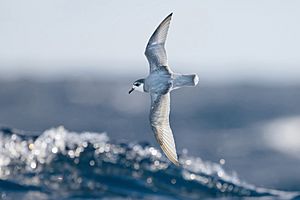Blue petrel facts for kids
Quick facts for kids Blue petrel |
|
|---|---|
 |
|
| In flight | |
| Conservation status | |
| Scientific classification | |
| Genus: |
Halobaena
|
| Species: |
caerulea
|
| Synonyms | |
|
Procellaria caerulea |
|
The blue petrel (Halobaena caerulea) is a small seabird. It belongs to the same family as shearwaters and other petrels, called Procellariidae. This little petrel is special because it's the only bird in its group, called Halobaena. It's also quite similar to birds known as prions. You can find blue petrels flying across the Southern Ocean. However, they only build their nests and raise their young in a few places, usually near the cold Antarctic Convergence zone.
Contents
About the Blue Petrel
The blue petrel is the only bird in its specific group, or genus, called Halobaena. It is part of a larger group of birds known as Procellariiformes. All birds in this group share some cool features.
For example, they have special nose passages called naricorns. These are attached to the top part of their beak. Their beaks are also unique, made of 7 to 9 hard plates.
These birds can also make a special stomach oil. This oil is stored in their stomach and is very rich in energy. They use it in two main ways: to spray at predators to protect themselves, and as a super-food for their chicks. Adults also use it to keep their energy up during long flights.
Another neat feature is a salt gland above their nose. This gland helps them remove extra salt from their bodies. Since they drink a lot of ocean water, this gland lets them get rid of the salt through a salty liquid from their nose.
The name "petrel" comes from Saint Peter. The story says he walked on water. Petrels often look like they are running on the water when they take off into the air.
What Does a Blue Petrel Look Like?
The blue petrel has feathers that are mostly blue-grey. It has a distinct "M" shape pattern across its back and wings. This pattern is similar to what you see on other prion birds. Its tail also has a white tip.
The blue petrel's bill is smaller compared to other prions. These birds are about 28 centimetres (11 in) long. Their wings can spread out to about 66 centimetres (26 in) wide.
Blue Petrel Behavior
How Blue Petrels Find Food
Blue petrels mainly eat tiny ocean creatures called krill. They also feed on other small crustaceans, fish, and squid. They are good divers and can go as deep as 6 m (20 ft) underwater to catch their food.
Reproduction and Life Cycle
Like many other seabirds, blue petrels live in large groups called colonies. They build their nests in burrows, which are like small tunnels in the ground. Each time they breed, the female lays one egg.
Both the mother and father bird take turns sitting on the egg to keep it warm. This is called incubating, and it lasts for about 50 days. Once the chick hatches, it stays in the nest for about 55 days until it is ready to fly, which is called fledging. Birds like Skuas are a big danger to their eggs and young chicks.
Where Blue Petrels Live
Blue petrels live in the southern oceans. You can find them as far north as South Africa, Australia, and parts of South America. They mostly breed in a specific band of latitude, between 47° and 56° South. This area is usually on either side of the cold Antarctic Polar Front.
They make their nests on subantarctic islands. Some of these islands include Marion Island, the Crozet Islands, Kerguelen Islands, Macquarie Island, and South Georgia.
In 2014, a new breeding colony was found on Gough Island. This island is much further north than where they usually breed. Even though this discovery is new, it doesn't necessarily mean the birds have just started breeding there. It might mean we just found out about it recently.
Protecting the Blue Petrel
The blue petrel has a very large area where it lives. Scientists estimate there are about 3,000,000 adult birds. Because there are so many of them and they live in such a wide area, the IUCN (International Union for Conservation of Nature) lists them as a species of Least Concern. This means they are not currently in danger of disappearing.
See also
 In Spanish: Petrel azulado para niños
In Spanish: Petrel azulado para niños




